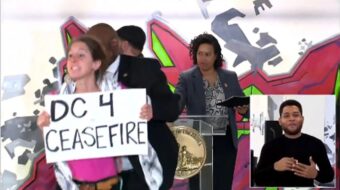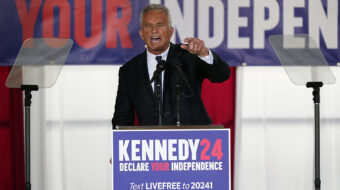Late on October 21, President Evo Morales visited with 1000 demonstrators in the streets of La Paz, who had walked 375 miles over two months from Beni department [administrative division] in Bolivia’s East. “I come to greet you with respect and affection,” he told them. They had arrived to press his government to reverse course and not build a highway through the Indigenous Territory and Isiboro Secure National Park (in Spanish, El Territorio Indígena Parque Nacional Isiboro-Sécure or TIPNIS). Morales reassured them that, indeed, he was recommending to the Legislative Assembly “that the road not pass through TIPNES.”
Morales apologized for a violent police attack on the marchers in Yucumo on September 25, and promised to negotiate with indigenous leaders on 15 other demands they brought. A special legislative session is required to change the law authorizing the highway.
TIPNIS, covering three million acres in Beni and Cochabamba, became a natural reserve in 1965 and indigenous property in 1990. The area, which borders Brazil, is home to 15,000 members of the Moxeño, Yuracaré and Chimán peoples. The proposed 191 mile highway between Beni and Cochabamba would save a 563 mile road trip around the reserve. It’s one segment of a multi-country highway project linking the Atlantic and Pacific coasts, significant for landlocked Bolivia. Construction on the 111 mile TIPNIS portion hasn’t begun.
Advocates for the project say TIPNIS highway would promote national integration. Also, a highway providing for a state presence in the remote region would allow crackdowns on illegal farming and forestry operations. President Morales had earlier bemoaned deforestation of 370,000 TIPNIS acres caused by out-of-control Bolivian and Brazilian agribusiness interests.
Not all of Bolivia’s indigenous peoples oppose TIPNIS highway. Many Quechua and Aymara indigenous people living in Bolivia’s western highlands back the highway. Many farmers from that region have settled in the TIPNIS Amazonian lowlands to grow coca. Speaking for them, Cochabamba-based activist Leonilda Zurita told reporters, “We will struggle until a decision is reached for all the citizenry and the integrated development of all the peoples.”
Indigenous writer Ollantay Itzamna comments that without highway access, “I never would have learned to write.” He would not deprive “my nephews and others of the possibility of knowing the modern world. For us indigenous, the highway is a question of life or death. The rest is romance.”
But according to TIPNIS protester Isidro Yujo, “We are the legal owners of the land, and we should make the decision on the road.” Protesting indigenous inhabitants see the road as opening up the reserve to agricultural, lumbering, and oil and gas operations. Supporting biodiversity, they demand a halt to gas and lumbering projects already started. And in furtherance of indigenous autonomy, they want administrative decentralization.
Some environmentalists accuse President Morales, whom the United Nations honored as a defender of “Mother Earth,” of inconsistency for opening up a mostly forested area to agricultural and hydrocarbon exploitation. Others criticize an indigenous president for infringing upon indigenous people’s territorial rights.
President Morales charged that some TIPNIS marchers contacted the U.S. embassy, “using TIPNIS to invite a U.S. invasion of Bolivia.” It should be noted that establishment forces in Santa Cruz, complicit in coup attempts against Morales’ government, also backed the march.
The police attack against marchers on September 25 triggered nationwide opposition to the highway project. Protesters flooded streets, forcing two government ministers to resign and provoking the COB (Central Obrera Boliviana), the country’s largest labor federation, to launch a 24-hour general strike. The TIPNIS protesters refused to let the President meet with them on their way to La Paz and spurned his proposal to let authorities in Beni and Chochabamba make the highway decision.
The Bolivian Communist Party, while denouncing the police action, claimed that some rightist or sectarian march leaders were displaying an intransigence aimed at embarrassing the government. The statement called for at least a temporary shelving of the highway and creation of a commission tasked with arranging for indigenous consultations prior to governmental actions.
For the government to give up on its highway project recalls mass protests in December 2010 forcing it to restore gasoline subsidies it had cut. Opinion surveys show that support for Morales, elected to a second term in 2009 with a 64 percent plurality, has fallen to 37 percent. With 60 percent of the ballots declared invalid, judicial elections on October 16 were a defeat for the government.
A day after the marchers arrived in La Paz, Morales submitted a new version of the law authorizing the highway to the Legislative Assembly. To refute claims that the legislation opens TIPNIS up to outsiders, Morales insisted on an article reaffirming their exclusion. He proposed another article nullifying the TIPNIS highway, also ones guaranteeing environmental rights and TIPNIS autonomy. A concluding provision authorizes the use of national security forces to remove outsider projects in the reserve.
Pablo Stefanoni, a Bolivian journalist and researcher in social sciences, concludes from the conflict that “Society [in Bolivia] is strong and the state weak, that divisions within the indigenous population are problematic for the Morales government, and that street action has once more shaken up a government unbeatable at the polls.

MOST POPULAR TODAY

High Court essentially bans demonstrations, freedom of assembly in Deep South

Zionist organizations leading campaign to stop ceasefire resolutions in D.C. area

U.S. imperialism’s ‘ironclad’ support for Israel increases fascist danger at home


UN warns that Israel is still blocking humanitarian aid to Gaza






Comments